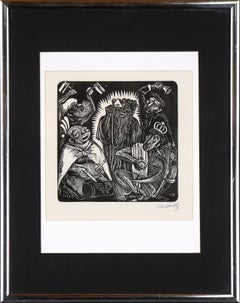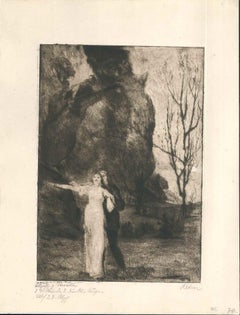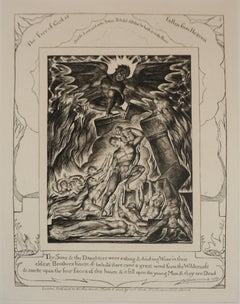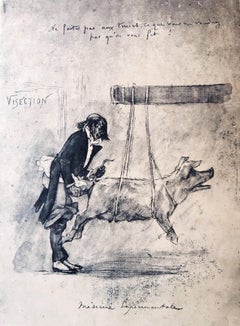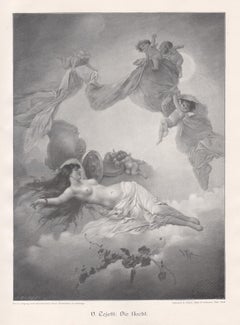Symbolist Figurative Prints
to
28
411
27
69
1
2
Overall Width
to
Overall Height
to
15,636
8,165
2,643
2,423
2,255
1,052
1,022
737
673
421
323
112
93
39
96
38
36
34
33
2
78
431
1
11
93
91
82
7
4
2
2
3
3
367
137
5
361
221
175
105
97
79
69
35
31
29
27
25
24
18
17
15
12
12
11
11
197
108
98
83
56
26
302
304
100
Style: Symbolist
God and the Four Evangelists ("Fool's Concert") - 1943 Linocut on Paper
Located in Soquel, CA
God and the Four Evangelists ("Fool's Concert") - 1943 Linocut on Paper
Leopoldo Méndez (Mexico City, Mexico, 1902–1969) "Fool's Concert" (from the portfolio "25 Prints of Leopoldo ...
Category
1940s Symbolist Figurative Prints
Materials
Linocut, Printer's Ink, Laid Paper
Mein Weg mit dem Weib #14 - Original Etching by W.R. Rehn
Located in Roma, IT
Drypoint and aquatint (brown ink) on cream paper.
Signed "Rehn" in pencil on the lower right margin. Titled and numbered in pencil on the lower left margin. Edition of 25 prints. Fr...
Category
1910s Symbolist Figurative Prints
Materials
Drypoint, Aquatint
Illustrations From The Book of Job - "The Fire of God is Fallen From Heaven"
Located in Soquel, CA
"Illustrations of the Book of Job" Engraving "The Fire of God is Fallen From Heaven...And the Lord said unto Satan Behold All that he hath is in thy Power"
Engraving, third printing...
Category
1870s Symbolist Figurative Prints
Materials
Handmade Paper, Engraving
$3,720 Sale Price
20% Off
Divine Comedy : Dante and Beatrice - Original lithograph, 1898
By Henri Martin
Located in Paris, IDF
Henri MARTIN
Divine Comedy : Dante and Beatrice, 1898
Original lithograph (Champenois workshop)
Printed signature in the plate
On vellum, 40 x 31 cm (c. 16 x 12 in)
INFORMATION: Li...
Category
1890s Symbolist Figurative Prints
Materials
Lithograph
Médecine Expérimentale - Etching by Félicien Rops - 1854
Located in Roma, IT
Médecine Expérimentale (Experimental medicine), is an original etching, soft ground, on Japanese paper realized by Félicien Rops in 1854, signed in the ...
Category
1870s Symbolist Figurative Prints
Materials
Etching
Die Nacht (The Night), nude and cupids, German antique engraving
By Virgilio Tojetti
Located in Melbourne, Victoria
'Die Nacht'
(The Night)
German wood-engraving, 1903.
310mm by 230mm (image)
410mm by 280mm (sheet)
Category
Early 20th Century Symbolist Figurative Prints
Materials
Engraving
1001 Nights - SURREALIST WOMAN DEAD IN A TREASURE BOX
Located in Santa Monica, CA
RICHARD TESCHNER (Prague 1879 – 1948)
From: A Thousand and One Nights -
SURREALIST WOMAN DEAD IN A TREASURE BOX, 1917 Aquatint, Proof no. 17. Aqua...
Category
1910s Symbolist Figurative Prints
Materials
Aquatint
Sleeping Diana - Original Woodcut by J.J. Weber - 1898
Located in Roma, IT
Image dimensions: 34.2 x 45.5 cm.
Sleeping Diana is an original print, realized in 1898.
Black and white woodcut print on applied Japon paper.
Good conditions except for yellowing of paper (especially along the margins), and very light folds on lower left side.
The print was realized by Johann Jacob Weber and it's part of the series Meisterwerke der Holzschneidekunst (original title: SECHZEHN HOLZSCHNITTE NACH GEMÄLDEN ARNOLD BÖCKLIN...
Category
1890s Symbolist Figurative Prints
Materials
Woodcut
Le Pendu (The Hanged Man) - Etching by Félicien Rops - 1868
Located in Roma, IT
The Hanged Man is an original etching realized by Félicien Rops in 1868, – 3rd state on 4, plate from “Uylenspiegel”, title "Le pendu, ou la mère gran...
Category
1860s Symbolist Figurative Prints
Materials
Etching
Sisyphus - Héliogravure by Jan Mesker - 1890
Located in Roma, IT
Sisyphus is a print realized by Jan Mesker after Antonio Zanchi, after Salvator Rosa in 1877/1890.
Héliogravure on paper.
Signed on the plate.
Good conditions.
Category
1890s Symbolist Figurative Prints
Materials
Photogravure
Psyche on a Rock - Etching by Max Klinger - 1909
By Max Klinger
Located in Roma, IT
Etching and aquatint realized in 1909.
Belongs to the series "Amor und Psyche. Opus V".
Very good condition.
Category
Early 1900s Symbolist Figurative Prints
Materials
Etching
Libro de Miguel Angel Dieguez - Woodcut by Joaquín Diéguez y Díaz - 1903
Located in Roma, IT
Libro de Miguel Angel Dieguez is a Modern Artwork realized in 1903, by the Spanish Artist Joaquín Diéguez y Díaz.
Coloured woodcut on paper. Hand signed on the back
The work is g...
Category
Early 1900s Symbolist Figurative Prints
Materials
Woodcut
Im Herbststurm - Etching by Fritz Schwimbeck - 1918
Located in Roma, IT
Etching realized by Fritz Schwimbeck in 1918.
Edition of 125 realized in Munich on mulberry paper.
Hand signed in pencil.
Category
1910s Symbolist Figurative Prints
Materials
Etching
Session VI, paper/etching, 63/75, 11x12 cm, 1988
Located in Riga, LV
Session VI, paper/etching, 63/75, 11x12 cm, 1988
Category
1980s Symbolist Figurative Prints
Materials
Paper, Etching
$573 Sale Price
20% Off
Fieber - Etching by Fritz Schwimbeck - 1918
Located in Roma, IT
Etching realized by Fritz Schwimbeck in 1918.
Edition of 125 realized in Munich on mulberry paper.
Hand signed in pencil.
Category
1910s Symbolist Figurative Prints
Materials
Etching
Figure - Original Etching by Michel Fingesten - Early 20th Century
Located in Roma, IT
Figure is an original etching artwork realized by Fingesten.
The state of preservation is good except for a line of folding.
Stamp on the rear "MICHEL FINGESTEN"
The artwork repre...
Category
Early 20th Century Symbolist Figurative Prints
Materials
Etching
Mein Weg mit dem Weib #11 - Original Etching by W.R. Rehn
Located in Roma, IT
Drypoint and aquatint (brown ink) on cream paper.
Signed "Rehn" in pencil on the lower right margin. Titled and numbered in pencil on the lower left margin. Edition of 25 prints. Fr...
Category
1910s Symbolist Figurative Prints
Materials
Drypoint, Aquatint
Bayros-Mappe III - Héliogravure by Fraz von Bayros - 1913
Located in Roma, IT
Héliogravure on japanese paper realized by Fraz von Bayros in 1913 for Ex Libris Verlag K. Th. Senger, Munich.
Mounted on passepartout. Edition of 260, hand signed in pencil by the ...
Category
1910s Symbolist Figurative Prints
Materials
Photogravure
Le Po au Lait - Original Etching by Félicien Rops - Late 19th Century
Located in Roma, IT
Le Pot au Lait is a beautiful and rare engraving of the second half of the XIX century, realized with different techniques by the Belgian artist Felicien Rops. This is a Last State a...
Category
Late 19th Century Symbolist Figurative Prints
Materials
Etching
Verlassene Muhle - Etching by Fritz Schwimbeck - 1918
Located in Roma, IT
Etching realized by Fritz Schwimbeck in 1918.
Edition of 125 realized in Munich on mulberry paper.
Hand signed in pencil.
Category
1910s Symbolist Figurative Prints
Materials
Etching
Jupiter and Venus - Etching by Max Klinger - 1909
By Max Klinger
Located in Roma, IT
Etching and aquatint realized in 1909.
Belongs to the series "Amor und Psyche. Opus V".
Very good condition.
Category
1880s Symbolist Figurative Prints
Materials
Etching
Traum - Etching by Fritz Schwimbeck - 1918
Located in Roma, IT
Etching realized by Fritz Schwimbeck in 1918.
Edition of 125 realized in Munich on mulberry paper.
Hand signed in pencil.
Category
1910s Symbolist Figurative Prints
Materials
Etching
Bayros-Mappe III - Héliogravu by Fraz von Bayros - 1913
Located in Roma, IT
Héliogravure on japanese paper realized by Fraz von Bayros in 1913 for Ex Libris Verlag K. Th. Senger, Munich.
Mounted on passepartout. Edition of 260, hand signed in pencil by the ...
Category
1910s Symbolist Figurative Prints
Materials
Photogravure
Auflosung - Etching by Fritz Schwimbeck - 1918
Located in Roma, IT
Etching realized by Fritz Schwimbeck in 1918.
Edition of 125 realized in Munich on mulberry paper.
Hand signed in pencil.
Category
1910s Symbolist Figurative Prints
Materials
Etching
Bayros-Mappe III - Héliogravure by Fraz von Bayros - 1913
Located in Roma, IT
Héliogravure on japanese paper realized by Fraz von Bayros in 1913 for Ex Libris Verlag K. Th. Senger, Munich.
Mounted on passepartout. Edition of 260, hand signed in pencil by the ...
Category
1910s Symbolist Figurative Prints
Materials
Photogravure
La Première Conscience du Chaos - Lithograph after Odilon Redon - 1923
By Odilon Redon
Located in Roma, IT
La Première Conscience Du Chaos is a lithograph realized after Odilon Redon.
It belongs to the suite "Odilon Redon Peintre, Dessinateur et Graveur", published by Henri Felury in 19...
Category
1920s Symbolist Figurative Prints
Materials
Lithograph
Bayros-Mappe III - Héliogravure by Fraz von Bayros - 1913
Located in Roma, IT
Héliogravure on japanese paper realized by Fraz von Bayros in 1913 for Ex Libris Verlag K. Th. Senger, Munich.
Mounted on passepartout. Edition of 260, hand signed in pencil by the ...
Category
1910s Symbolist Figurative Prints
Materials
Photogravure
The Harem - Heliogravure - 1906
Located in Roma, IT
Image dimensions: 17.7 x 13.5 cm.
The Harem is a black and white héliogravure on paper, realized in 1906 by an anonymous Austrian artist.
An original illu...
Category
Early 1900s Symbolist Figurative Prints
Materials
Engraving
Les Fleurs du Mal - Complete Series of 12 etchings by M. Van Maele - 1917
By Martin Van Maele
Located in Roma, IT
Les Fleurs du Mal is an original series of 12 etching, realized by Martin Van Maele in 1917, illustrations for Charles Baudelaire’s poems, printed by La Bibliothèque des Curieux, loose leaves each of them.
The artworks are illustreting of Les Fleurs du mal "The Flowers of Evil" that is well-known poetry written by Charles Baudelaire, Which first published in 1857 that was important in the symbolist and has a great impact on modernist movement of the era.
In very good conditions.
Maurice François...
Category
1910s Symbolist Figurative Prints
Materials
Etching
The European Macabre Dance N.2 - Lithograph by A. Martini - 1915
Located in Roma, IT
The European Macabre Dance N.2 is an hand-colored lithograph, from the Series "La Danza Macabra Europea" illustrated by Alberto Martini (Oderzo, 1876 – Milan, 1954) in 1915.
Signed...
Category
1910s Symbolist Figurative Prints
Materials
Lithograph
Meeting, paper/etching, 11.5x12.5 cm
Located in Riga, LV
Meeting, paper/etching, 11.5x12.5 cm
Category
1980s Symbolist Figurative Prints
Materials
Paper, Etching
$573 Sale Price
20% Off
Profil de Lumière - Lithograph after Odilon Redon - 1923
By Odilon Redon
Located in Roma, IT
Profil de Lumière is a phototype reproduction realized after Odilon Redon.
They belong to the suite "Odilon Redon Peintre, Dessinateur et Graveur", published by Henri Felury in 192...
Category
1920s Symbolist Figurative Prints
Materials
Lithograph
Bayros-Mappe III - Héliogravure by Fraz von Bayros - 1913
Located in Roma, IT
Héliogravure on japanese paper realized by Fraz von Bayros in 1913 for Ex Libris Verlag K. Th. Senger, Munich.
Mounted on passepartout. Edition of 260, hand signed in pencil by the ...
Category
1910s Symbolist Figurative Prints
Materials
Photogravure
Bayros-Mappe III - Héliogravure by Fraz von Bayros - 1913
Located in Roma, IT
Héliogravure on japanese paper realized by Fraz von Bayros in 1913 for Ex Libris Verlag K. Th. Senger, Munich.
Mounted on passepartout. Edition of 260, hand signed in pencil by the ...
Category
1910s Symbolist Figurative Prints
Materials
Photogravure
Bayros-Mappe III - Héliogravure by Fraz von Bayros - 1913
Located in Roma, IT
Héliogravure on japanese paper realized by Fraz von Bayros in 1913 for Ex Libris Verlag K. Th. Senger, Munich.
Mounted on passepartout. Edition of 260, hand signed in pencil by the ...
Category
1910s Symbolist Figurative Prints
Materials
Photogravure
Bayros-Mappe III - Héliogravu by Fraz von Bayros - 1913
Located in Roma, IT
Héliogravure on japanese paper realized by Fraz von Bayros in 1913 for Ex Libris Verlag K. Th. Senger, Munich.
Mounted on passepartout. Edition of 260, hand signed in pencil by the ...
Category
1910s Symbolist Figurative Prints
Materials
Photogravure
Bayros-Mappe III - Héliogravu by Fraz von Bayros - 1913
Located in Roma, IT
Héliogravure on japanese paper realized by Fraz von Bayros in 1913 for Ex Libris Verlag K. Th. Senger, Munich.
Mounted on passepartout. Edition of 260, hand signed in pencil by the ...
Category
1910s Symbolist Figurative Prints
Materials
Photogravure
Banquet of Love - Etching by Alberto Martini - 1917
Located in Roma, IT
Banquet of love is a modern artwork realized by Alberto Martini in 1917.
Etching and drypoint. Second state of three.
Signed on plate
Printed in 1945 in 25 specimen.
Alberto Mar...
Category
1910s Symbolist Figurative Prints
Materials
Etching
Mein Weg mit dem Weib #18 - Original Etching by W.R. Rehn
Located in Roma, IT
Drypoint and aquatint (brown ink) on cream paper.
Signed "Rehn" in pencil on the lower right margin. Titled and numbered in pencil on the lower left margin. Edition of 25 prints. Fr...
Category
1910s Symbolist Figurative Prints
Materials
Drypoint, Aquatint
Pirates attack the Castle on the Sea - Original Woodcut by J.J. Weber - 1898
Located in Roma, IT
Image dimensions: 23 x 35 cm.
Original Title: Von Piraten überfallene Burg am Meer
Pirates attack the Castle on the sea is a black and white xylograph on Japon applied on ivory-colored paper, after Arnold Böcklin...
Category
1890s Symbolist Figurative Prints
Materials
Woodcut
Femme Espèrent - Photolithograph after Constantine Guys - Early 20th Century
Located in Roma, IT
Femme espèrent is a wonderful original photolithograph applied on paper, realized after the French artist, Guys Constantin (1802 -1892).
In very good condition, including a petrol-g...
Category
Early 20th Century Symbolist Figurative Prints
Materials
Photogravure
Mein Weg mit dem Weib - Original Etching by W.R. Rehn
Located in Roma, IT
Etching and aquatint on cream paper.
Signed in pencil on the lower right margin. Titled and numbered in pencil on the lower left margin. Edition of 25 prints.
Plate in excellent co...
Category
1910s Symbolist Figurative Prints
Materials
Drypoint, Aquatint
Fall Der Engel - Vintage Héliogravure by Franz von Bayros - 1921 ca.
Located in Roma, IT
Fall Der Engel is a black and white héliogravure on cream-colored cardboard realized by Choisy Le Conin, as is remembered Franz Von Bayros (Agram, 1866 – Vienna, 1924).
From Mappe, ...
Category
1920s Symbolist Figurative Prints
Materials
Engraving
The European Macabre Dance N.38 - Lithograph by A. Martini - 1915
Located in Roma, IT
The European Macabre Dance N.38 is a hand-colored lithograph, from the Series "La Danza Macabra Europea" illustrated by Alberto Martini (Oderzo, 1876 – Milan, 1954) in 1915.
Signed ...
Category
1910s Symbolist Figurative Prints
Materials
Lithograph
The European Macabre Dance N.28 - Lithograph by A. Martini - 1915
Located in Roma, IT
The European Macabre Dance N.28 is a hand-colored lithograph, from the Series "La Danza Macabra Europea" illustrated by Alberto Martini (Oderzo, 1876 – Milan, 1954) in 1915.
Signed...
Category
1910s Symbolist Figurative Prints
Materials
Lithograph
The European Macabre Dance n.25 - Lithograph by A. Martini - 1915
Located in Roma, IT
The European Macabre Dance n.25 is a hand-colored lithograph, from the Series "La Danza Macabra Europea" illustrated by Alberto Martini (Oderzo, 1876 – Milan, 1954) in 1915.
Origina...
Category
1910s Symbolist Figurative Prints
Materials
Lithograph
The European Macabre Dance N.40 - Lithograph by A. Martini - 1915
Located in Roma, IT
The European Macabre Dance N.40 is a hand-colored lithograph, from the Series "La Danza Macabra Europea" illustrated by Alberto Martini (Oderzo, 1876 – Milan, 1954) in 1915.
Signed on the plate, Original Edition.
Published by Domenico Longo, Treviso.
Handcolored lithographic postcards.
Very good conditions.
Alberto Martini (Oderzo, 1876 - Milan, 1954); was an Italian draftsman, painter, engraver and illustrator, forerunner of the surrealist movement...
Category
1910s Symbolist Figurative Prints
Materials
Lithograph
Verfuhrung - Vintage Héliogravure by Franz von Bayros - Early 20th Century
Located in Roma, IT
"Verfuhrung" is an original Black and white héliogravure on cream-colored cardboard realized by Choisy Le Conin, pseudonym of Franz Von Bayros (Agram, 1866 – Vienna, 1924).
From Ma...
Category
Early 20th Century Symbolist Figurative Prints
Materials
Engraving
Candid Oder der Optimismu - Original Rare Book Illustrated by Max Unold - 1913
Located in Roma, IT
Candid oder der optimismus is an original modern rare book written by Voltaire and illustrated by Max Unold (Memmingen, 1885 - Munich, 1964) in 1913.
Original Edition.
800 Numbere...
Category
1910s Symbolist Figurative Prints
Materials
Paper, Lithograph
Two Soldiers - Original Lithograph by A. Kubin - 1933
By Alfred Kubin
Located in Roma, IT
Zwei Soldaten is an original lithograph on paper, realized by Alfred Kubin in 1933, Hand-signed in pencil.
Sheet dimension: 27,5 x 22,5cm.
In very good conditions.
References:
Arn...
Category
1930s Symbolist Figurative Prints
Materials
Lithograph
Les Aveugles ( The Blind )
Located in Paonia, CO
Henri DeGroux (1866-1930) was a Belgian Symbolist painter, sculptor and lithographer. He was known for his allegorical, religious and historical subject matter. He became an inspired...
Category
1910s Symbolist Figurative Prints
Materials
Lithograph
Ambulkance
Located in Paonia, CO
Henri DeGroux (1866-1930) was a Belgian Symbolist painter, sculptor and lithographer. He was known for his allegorical, religious and historical subject matter. He became an inspired...
Category
1910s Symbolist Figurative Prints
Materials
Lithograph
In Schnee - Etching by Fritz Schwimbeck - 1918
Located in Roma, IT
Etching realized by Fritz Schwimbeck in 1918.
Edition of 125 realized in Munich on mulberry paper.
Hand signed in pencil.
Category
1910s Symbolist Figurative Prints
Materials
Etching
Bayros-Mappe III - Héliogravure by Fraz von Bayros - 1913
Located in Roma, IT
Héliogravure on japanese paper realized by Fraz von Bayros in 1913 for Ex Libris Verlag K. Th. Senger, Munich.
Mounted on passepartout. Edition of 260, hand signed in pencil by the ...
Category
1910s Symbolist Figurative Prints
Materials
Photogravure
Der Büsser - Original Woodcut by J.J. Weber - 1898
Located in Roma, IT
Image dimensions: 34 x 19 cm.
Der Büsser is an original print, realized in 1898.
Black and white xylograph on applied Japon paper.
Good conditions except for yellowing of paper (especially along the margins), and little stains on lower margin.
The print was realized by Johann Jacob Weber and it's part of the series Meisterwerke der Holzschneidekunst (original title: SECHZEHN HOLZSCHNITTE NACH GEMÄLDEN ARNOLD BÖCKLIN...
Category
1890s Symbolist Figurative Prints
Materials
Woodcut
Ghosts of New York 2, monochromatic dramatic city-scape surrealistic undertones
By Tom Bennett
Located in Brooklyn, NY
One of a series of oil-based monotypes on fine printmaking paper. Monochromatic with subtle color. Moody, symbolist/expressionist image reflecting on NY city's ambient current and past.
Category
2010s Symbolist Figurative Prints
Materials
Monotype, Archival Paper
Prêtresse antique (Ancient Priestess)
Located in Middletown, NY
Heliogravure by Félicien Rops (1833 – 1898), a Belgian artist, known primarily as a printmaker in etching and aquatint. He is noted for his drawings depicting erotic and Satanic them...
Category
Late 19th Century Symbolist Figurative Prints
Materials
Handmade Paper, Photogravure, Stencil
Die Nixen (Mermaids), nudes, German antique engraving
By Virgilio Tojetti
Located in Melbourne, Victoria
'Die Nixen'
(Mermaids)
German wood-engraving, 1903.
230mm by 320mm (image)
280mm by 410mm (sheet)
Category
Early 20th Century Symbolist Figurative Prints
Materials
Engraving
Christophorus II - Lithograph by Hans Thoma - 1916
By Hans Thoma 1
Located in Roma, IT
Lithograph realized by Hans Thoma in 1916 on light yellow paper.
Date and monogrammed in the plate.
Hand signed lower right.
Very good condition.
Category
1910s Symbolist Figurative Prints
Materials
Lithograph
Die Balldame - Etching by Max Klinger - 1884
By Max Klinger
Located in Roma, IT
Rare etching realized by Max Klinger in 1884.
II state on 2.
Image dimensions: 13.9x19 cm.
Very good condition except for some diffused foxing in the margins.
Ref. Singer, 284.
Category
1880s Symbolist Figurative Prints
Materials
Etching
Symbolist figurative prints for sale on 1stDibs.
Find a wide variety of authentic Symbolist figurative prints available for sale on 1stDibs. Works in this style were very popular during the 21st Century and Contemporary, but contemporary artists have continued to produce works inspired by this movement. If you’re looking to add figurative prints created in this style to introduce contrast in an otherwise neutral space in your home, the works available on 1stDibs include elements of blue, orange and other colors. Many Pop art paintings were created by popular artists on 1stDibs, including Michel Fingesten, Abel Pann, Franz von Bayros (Choisi Le Conin), and Ferdinand Hodler & R. Piper & Co.. Frequently made by artists working with Lithograph, and Woodcut Print and other materials, all of these pieces for sale are unique and have attracted attention over the years. Not every interior allows for large Symbolist figurative prints, so small editions measuring 1.58 inches across are also available. Prices for figurative prints made by famous or emerging artists can differ depending on medium, time period and other attributes. On 1stDibs, the price for these items starts at $55 and tops out at $378,675, while the average work sells for $436.
Still Thinking About These?
All Recently ViewedMore Ways To Browse
Edward Simmons
Edwin Lord Weeks
Elizabeth Enders
Elizabeth Horning
Emil Holzhauer
England Church Oil Painting
English Deer Painting
English Fox Hunt Painting
English Toy Terrier
Enrique Martinez Celaya
Eric Aho
Eritrea Art
Ernest Chateignon
Erotic Art Animal
Eugene Chigot
Eugene Devaud De Madelin
Eugene Jardin
Faith Sheppard
